Finding Real Food in the Grocery Store
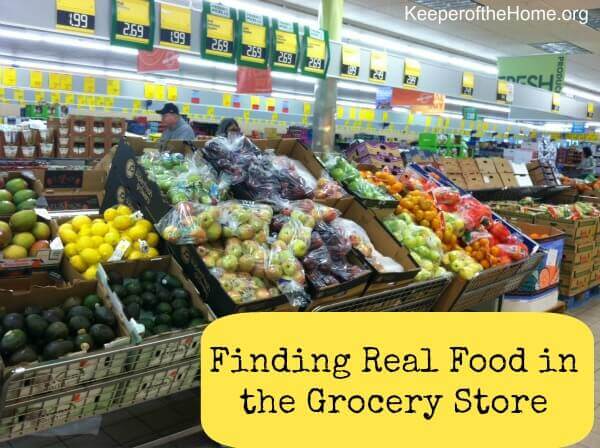
By Erin, Contributing Writer
Are you working to ditch processed foods and put more real food on the table? This month we’re running a series called Real Food Made Simple: A Beginner’s Guide to Eating Better. Our goal is to answer the questions you might have and make the transition a whole lot easier!
One of the biggest eye-openers for me when I first started my real food journey was that so many real foodies shop directly from the farmer or purchase food online.
I was accustomed to using coupons for processed foods at mainstream grocery chains–or buying food for rock-bottom prices at my still-beloved Aldi.
And, truth be told, although we’ve taken baby steps like planting our own garden, purchasing some items online, and buying a very small amount of meat and eggs from a local farmer, the majority of our food still comes from a “real” brick-and-mortar grocery store.
If you are brand new to real food, then I imagine the thought of locally sourcing your food is exciting and ideal–but perhaps a little overwhelming at first.
So let’s back up a bit and take a tour of the local grocery store you frequent. I’ll walk you through each section of the store and virtually point out what to buy, what to leave on the shelf and where to compromise.

A Virtual “Tour” of Your Grocery Store
Produce
If you are cooking real food, this will be one of the sections where you spend most of your time.
What to Buy: Aim to purchase as much organic and/or locally-grown produce as your budget allows–if your store carries it. (Many don’t.)
What to Leave: Don’t buy from the dirty dozen list or conventional corn, summer squash and zucchini, or Hawaiian papaya, which are largely genetically modified.
Where to Compromise: Focus on purchasing non-organic items from the clean 15 list. If there’s an item on the dirty dozen that you absolutely cannot live without, and you cannot find the organic version, give yourself grace and buy it every once in a while–but commit to cut back on your consumption of it.
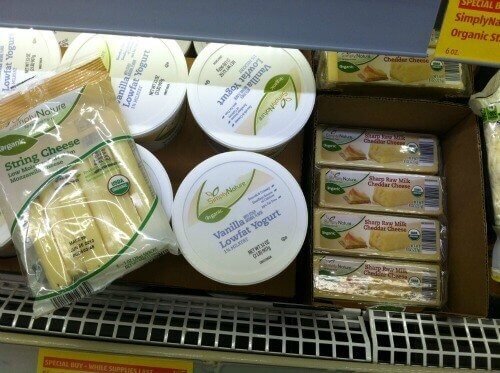
Dairy
What to Buy: Aim to purchase full fat, organic dairy (raw, if, by chance, you’re in a state that sells it in a grocery store!). If you cannot find organic dairy, look for dairy made from grassfed cows (like Kerrygold Cheese, which my local BJ’s carries). (See Diana’s post for further explanation about dairy options beyond the grocery store!)
What to Leave: Absolutely, positively leave any processed cheeses (i.e. Velveeta, American cheese slices, etc.) on the shelf. Also leave full-fat dairy made from cows given hormones.
Where to Compromise: Purchase dairy that is made from cows not treated with the rBGH growth hormone. (It will usually say it somewhere on the package.)
If you cannot find any hormone-free cheese, opt for regular (non-processed) cheeses that are natural in color (white). The back of the package will say whether or not color has been added.
If you cannot find any hormone-free milk, I would personally ditch the dairy milk and choose coconut, almond, or even rice milk instead. (But stay far away from soy milk!)

Image by bgottsab
Eggs
What to Buy: Aim to purchase organic eggs from free-range/cage-free/certified humanely-raised chickens (locally raised if your store happens to carry them).
What to Leave: Ditch the egg replacers (unless we’re talking flax meal or chia seed!). What’s in those things any way?!
Where to Compromise: If organic eggs are not available, at least look for cage-free/free-range eggs (although this label can be sketchy and not necessarily indicate chickens who roam in the grass and scratch in the dirt for worms). Next, opt for conventional eggs. Sure, they may not be organic, but some eggs are better than no eggs.
Meat
What to Buy: Aim to purchase organic meat and wild-caught seafood.
What to Leave: It’s time to give up the processed chicken nuggets, fish sticks, Spam and other pseudo meats.
Where to Compromise: If organic meat is not an option, first look for meats with the label “hormone/antibiotic-free.” If you cannot find any meat that fits that bill, purchase conventional–yet unprocessed–meats and farm-raised fish, but commit to lowering your meat consumption and supplementing with other sources of protein, such as beans. (Kitchen Stewardship’s The Everything Beans Book is a good place to start for meatless meals recipes!).
Also, try to vary your meats so you aren’t always eating one certain type that may be overexposing your family to certain antibiotics, etc.
Image by stevendepolo
Frozen Foods
What to Buy: Aim to purchase frozen organic produce and meats that contain no additives, seasonings, etc.
What to Leave: Pass over the pre-made, processed meals and pre-seasoned veggies, etc.
Where to Compromise: Purchase conventional frozen foods that are whole and not processed.
Beans/Legumes
What to Buy: Aim to purchase organic dried beans and legumes.
What to Leave: Opt out of the packaged beans and legumes (whether canned or frozen) that have been pre-seasoned.
Where to Compromise: Purchase conventional dried beans, or give yourself grace during busy seasons and buy canned beans–even though most canned goods contain BPA.

Condiments
What to Buy: Don’t buy them. Make your own.
What to Leave: Any condiments that list high fructose corn syrup, soy, or any of these ingredients (or anything you can’t pronounce) should be left on the shelf.
Where to Compromise: Purchase organic versions and/or versions that contain 5 ingredients or less–and all ingredients that you can recognize.
Sweeteners
What to Buy: Raw, unfiltered honey, grade B maple syrup, stevia and blackstrap molasses will be your best options for sweeteners that you may find in your local grocery store–along with some of the others mentioned in this post.
What to Leave: Say goodbye to white sugar–especially white sugar made from sugar beets, which are largely GMO. But if your hubby absolutely must have his sweet tea with white sugar, don’t cause a fuss. Let him. Oh, and leave behind the brown sugar, Karo syrup, agave nectar, and ANY artificial sweeteners as well.
Where to Compromise: If your store does not contain any of the above “best” options, look for regular honey, but try to get a version that has all been made in the same country. Make sure it’s 100% pure honey and doesn’t contain high fructose syrup.
Next, look for grade A 100% pure maple syrup (I get mine at Aldi.) or 100% pure molasses. Lastly, try to find white sugar made from sugar cane instead of sugar beets.
And if plain white sugar is all you can find, then it’s better than artificial sweeteners–any day.
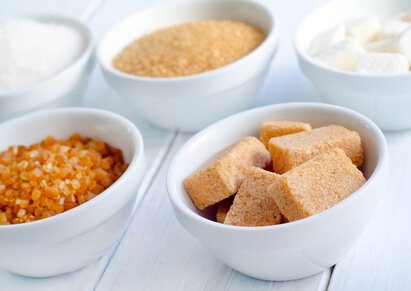
Baking Supplies
What to Buy: Aim to purchase whole wheat or white whole wheat flour, one of the sweeteners listed above, and coconut (most Wal-marts carry it!), olive or grapeseed oils.
What to Leave: Don’t give white flour a second glance–and it’s time to put canola and vegetable oils away as well. And, of course, don’t even enter the aisle that carries pre-made baked goods!
Where to Compromise: Most store should have whole wheat flour and at least olive oil. You shouldn’t have to compromise as much here.
Beverages
One word: Water. Save the money you would be spending on soft drinks and juices and one day you can buy a Berkey water filter! (See “Dairy” for milk options.)
Snacks
What to Buy: Aim to purchase the supplies to make your own snacks. (Yes, you really can make healthy snacks “to go”!)
What to Leave: Skip the inner, snack aisles altogether! There is not much good there!
Where to Compromise: Opt for snack foods that contain 5 “real food” ingredients or less. At our house that includes veggie chips and rice cakes.
Canned/Boxed Foods
What to Buy: Don’t. Buy the ingredients and make your own “boxed” meals that are better than a box.
What to Leave: Um, just about everything!
Where to Compromise: OK, well, you could buy canned tomatoes. Those at least retain some nutritional value. And I also buy pasta in a package. Opt for whole wheat or brown rice, quinoa or GMO-free corn pasta if you are gluten free.
So what’s the bottom line when it comes to real food grocery shopping?
If you remember nothing else about this post, I want you to remember this: Shop the outer perimeter of the grocery store and avoid the inner aisles. The outside is where the whole foods are stocked. And read each and every food label very closely!
Further Reading
Did you know that Stephanie wrote an entire series on this topic in the early days of Keeper of the Home? There are some great little nuggets to dig out of the following posts:
The Secrets of Where Real Foodies Buy Their Ingredients
A Real Foodie’s Pantry & Cupboards
Making the Best of the Regular Grocery Store
Making the Best of the Regular Grocery Store: Inner Aisles
Making the Best of the Regular Grocery Store: Breads and Pastas
Making the Best of the Regular Grocery Store: Meats
Making the Best of the Regular Grocery Store: Produce and Seafood
Making the Best of the Regular Grocery Store: Dairy
How to Buy Meat, Poultry and Eggs in a Regular Grocery Store
Real Food Begins with the Right Ingredients
Finding High Quality Sources for the Real Food Diet
Other posts in the series:
Real Food Made Simple: A Beginner’s Guide to Eating Better
Cutting Your Kitchen Prep Time in Half — Or More!
Confessions of a Formerly Picky Eater
The Grain Controversy: Should We Eat Them or Not?
Second Steps Towards Eating Real Foods: Switching Your Food Sources
Sweeteners: How They Affect You, Which Ones are Best, and How to Use Them
Simple Steps to Begin Cooking Homemade: Pantry Staples
5 Strategies to Help Your Husband and Kids Transition to Real Food
20 Easy Real Food Switches and Substitutions {with Free Printable Chart}
First Steps to Eating for Fertility
Keeping Costs Down in a Real Food Kitchen
5 Ways to Get More Fruits & Veggies into your Diet
Food Is Not Cheap: 4 Steps to Budgeting in Real Food
Simple Steps to Begin Cooking Homemade: Baked Goods
Simple Roast Chicken (And Fabulous Side Dish Recipes!)
17 Homemade Spice Mixes {with Recipes & Why You Should Use Them!}
5 Ways Green Living and Real Food are Connected
Simple Steps to Begin Cooking Homemade: Soups, Sauces, and Simple Dinners
Do you shop for real food in a grocery store? What real foods do you buy at your grocery store?
*Disclosure: This post contains affiliate links.
;

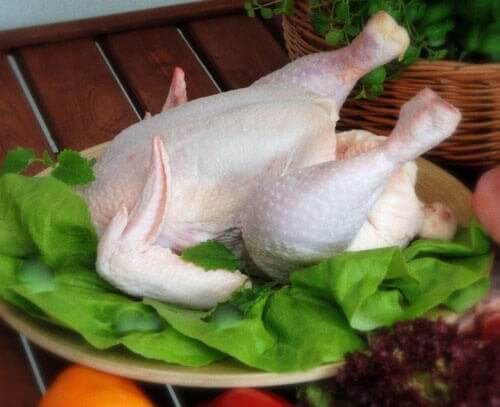
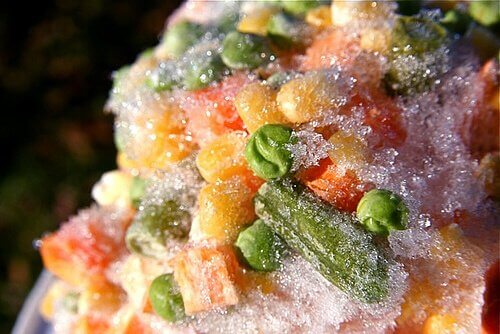




Wow! This will take a while to absorb. We have been making small changes in our diet, but it is interesting to find out that things you think are better (like Soy milk) aren’t really that good for you. I’ve added this post to my Evernote folder so I can re-read it a few times. Thank you for all the info!
I felt the same way when I found out about soy! Hope this helps you!
Great list! However, when it comes to flour, from the research I have done I have found it is best to grind your own & freeze it to keep it from going rancid if you won’t be immediately using it OR if you have to buy it store bought, best to buy organic, unbleached, unbromated, unenriched WHITE flour (Bob’s Red Mill & Arrowhead Mills are both good brands). Store bought whole wheat flour will go rancid & grow fungus long before white flour. Flour that isn’t fresh is also pretty void of nutrients, so it doesn’t matter if it’s whole wheat or not. I like this article from Butter Believer: http://butterbeliever.com/is-white-flour-really-that-bad/
When I shop the grocery store, I might buy produce (organic and clean 15), organic whole milk yogurt, brie cheese from grass-fed cows, wild Alaskan salmon, organic chicken, organic butter (or Kerrygold grass-fed), organic salsa, organic nuts, fresh sourdough bread, Ezekiel bread, organic chocolate & chocolate chips (soy free), organic peanut butter, raw & local honey, arrowroot powder, and toilet paper. Everything else we purchase locally from farmers or online (mostly through Azure Standard). It’s really nice to not spend much time at the grocery store anymore & so convenient to get the bulk of everything in one monthly order!
Thanks again for this great real foods break down! Starting out would have been a lot easier if I had a list like this to look at during that time. A word of encouragement to those new to real food, it DOES get easier over time!!! 🙂
Thanks for the tip on the white flour! I’ll have to look into that and may update the post (when the kids are in bed! LOL!). I tried to write it as if people didn’t have access to anywhere but the grocery store, but I agree about grinding your own. I wish most stores sold whole grains! I LOVE my WonderMill!! I use it to make gluten-free flours, though, since most of my family is gluten free. I wish we had Azure Standard here in NC! I have heard amazing things about it! And thanks for the encouragement about it getting easier! I know just going shopping is so overwhelming at first!
I’m surprised no one has mentioned hunting as a source of clean, pastured meat. My hubby is a hunter, and our freezers are full of grass-fed venison–no antibiotics, no worry about BSE, no ethical gripes about factory farms, and very little cost if you butcher it yourself. Granted, start-up costs for guns and ammo are relatively high, and it takes a certain character and interest to be a hunter, but a one-shot kill is more humane than a bolt to the head. And it’s more tasty. Now, if we only had wild cows in these parts…
If you’re in the Midwest, your deer are most definitely feasting on GMO corn, though. Still better than conventional factory farming, but I’m always surprised that people don’t think of that.
I agree! My husband is a hunter, and we are usually stocked up. Been a slow year here in Texas, though. I do have to say, that if we didn’t have really good connections (several of our friends own land) then it would not be affordable for us to lease land for my husband to hunt. So it is only a good value for those lucky ones with good connections.
I agree about the GMO corn. I’ve given my lecture that they shouldn’t be offering supplemental feeds, and I get a “yeah, right” response. At the end of the season, I think it is safe to say that the deer aren’t exactly grass fed since they get so many ranches feeding them. Unless he hunts a high fenced location, and the owners don’t feed, then it really isn’t truly a substitute for free-range meat. But my husband loves it and it is so affordable that we eat it!
Also, many people don’t know that the butcher usually adds pig fat to ground venison to make it taste better. However, the pig fat is most likely the conventional sort. I ask for no fat added, then add my own (either butter, coconut oil, lard, or tallow) when I’m cooking.
This particular post was about the food you can get in a grocery store–but I have a feeling one of the other authors will be mentioning wild game!
So when you’re baking what would you replace brown sugar, corn syrup and their ilk with? I dont think you can replace all those ingredients with just honey and maple syrup, can you?
I do not bake a ton, but I have had no problems replacing granulated sugars–rather white or brown–with sucanat or organic sugar (evaporated cane juice). The sucanat will be more like brown sugar & may take a little getting used to because it is not as sweet. It’s texture is also a little different, but it is still granulated & it’s brown in color. I also bake with honey & maple syrup so that is another option, but it’s not always a cup for cup measurement. I have successfully switched to both of those any time I need a liquid sweetener, but I was never one to use corn syrup. The only time I ever used Karo was in a candy recipe my husband’s grandmother made & I haven’t made it in years but I think I could easily use honey instead. Hope that helps!
*whether* not *rather*!
Is there something wrong with brown sugar aside from being unnecessary added sugar (like do they use dangerous chemicals to process it or genetically modify it somehow?)? Because if not, I would think it’s okay in moderation for baking/candy making et cetera.
Thank you so much, this is so helpful to me, I have printed it off for my new “cookbook”.
I’m so glad it helped!
Nice post – lots of tips for beginners .
Thanks!
Great list – and very helpful for anyone trying to eat real food. I am curious – why is Grade B maple syrup better than grade A? Do you know?
From what I understand, grade B is richer in nutrients & less processed.
I’m so glad you asked! I wondered this myself for the longest time! Here is a good article I found that explains the difference: http://www.maplesyrupworld.com/pages/Maple-Syrup-Grading.html. Here is some good info. about the health benefits of grade B: http://www.livestrong.com/article/401632-health-benefits-of-grade-b-maple-syrup/.
I have personally not seen it in my local grocery store, and since I don’t use it often, I just go with the 100% grade A at my Aldi. It sure beats white sugar! 🙂
Thank you for such a balanced post. So many real food blogs push the buy direct from the farmer, or co-ops, and it can be discouraging, especially when we try to find farmers on local harvest and get nothing, and the closest Azure drop point is 2 hours away. It’s nice to see a post like this.
I’m so glad it blessed you! I tried to pretend that I was walking with a reading through her store–and ALL she had was what was in that store. I SO wish we had Azure as well! I think our closest drop-off is like 4-5 hours away! LOL! We do the best we can!
Great article! I think you’ve provided a very helpful starting point. One comment about eggs; either buy certified organic or just go conventional. You mention “cage-free” and “free-range” are not well regulated, which is so true. Given the extra cost of eggs with those labels, unless they are also organic they are not worth your money (no better than conventional eggs). That doesn’t hold true if you are buying locally sourced eggs, but for sure if you are buying big name brands.
That’s a really good point! Why waste the money when the label is so sketchy! We are thankful to have a good local source.
Question. You wrote that people shouldn’t use Agave. I have tried every non sugar sweetener (I was told that because I have PCOS I have to carefully watch what sweeteners I use and to stay away from white). I was told agave was a good substitute. I use stevia as well, but I get a mild sore throat when I get it (similar to the site throat I get when I have used Splenda or aspartame- usually not knowing it was in the drink).
Here is some info on agave: http://articles.mercola.com/sites/articles/archive/2010/03/30/beware-of-the-agave-nectar-health-food.aspx.
Stephanie is on vacation at the moment, but perhaps when she returns she can weigh in. She has experienced PCOS & I know she uses pure grade B maple syrup & raw honey.
Thank you, this is a helpful post. I have to admit, it really had not occurred to me that people could not feed their families real food by shopping at the grocery store – maybe I am not “real” enough. I shop primarily at two major chains, with a few things supplemented by trips to Publix or Whole Foods. The idea that people need to buy most of their foods directly from farmers or real food online sources grates a bit with me, because that is completely unattainable for many families. So I appreciate advice that is realistic for more people, like this post.
I used to think the same way! It’s really exciting to think of sourcing food directly from the farm, but I am not 100% there yet, and I hope this post will encourage many that you can eat mostly real at the grocery store! We do the best with what we have!
Speaking of avoiding soy, what you would recommend for an almost-1 year old when it’s time to move on to whole milk? She isn’t tolerating dairy very well so I won’t do milk, but I want to avoid soy milk. Thoughts, anyone?
I would first consult your pediatrician, naturopath or other trusted healthcare provider. I personally nurse until my babies self-wean. For my oldest, that was 22 months and for my second it was 18 months. I knew my second wasn’t tolerating dairy well, so I started her on coconut milk and then moved her to almond milk (I was cautious with the almond because my husband has a tree nut allergy). I have heard that raw milk is more tolerable and has the benefit of the good living enzymes. I do not have access to legal and affordable raw milk, however. If you do, this may be a route for you to take. But if it were me, I would nurse if the baby still wanted to nurse. That will give you a little more time to research!
I’ve also heard that goat’s milk can be good for those who have an intolerance.
I second the recommendations to nurse until your child self-weans and then try goat’s milk; in fact, I’m really surprised this article didn’t mention goat’s milk as an alternative to conventional cow’s milk. It’s really, really good for you: naturally cultured and usually very well tolerated by people with lactose intolerance (or sometimes even true dairy allergy). That being said, a lot of people find it prohibitively expensive, and your grocery might not carry it. If that’s your situation, I’d go with almond milk over coconut milk. Almond milk has a ton of vitamin E, a potent antioxidant that’s really good for people with inflammatory issues like dietary intolerances.
I found this somewhat helpful, so went to the grocery store to see what I could find. Sure, I found the things suggested in this article, but quickly became frustrated and discouraged. Why? Almost all of these suggestions cost more and we just can’t afford to make these “simple” changes, even though we would really like to. Organic butter is $6 per pound (couldn’t find any grassfed), I pay $2.39. Grass fed beef is 2-4x the cost of the other stuff (really, $18 for 1 steak?). Organic milk is $5.99+ per gallon, I pay 2.95, but at least claims it’s farmers pledge not to use growth hormones. Real maple syrup is $13.99 for 12oz, I pay $1.99 for whatever’s on sale. Organic produce is about $2 more per pound/container. Couldn’t find grass fed cheeses. Is anyone else struggling with the financial impact of real food? I totally understand the benefits and really do want what’s best for my family, but until the prices come down, I can’t make it happen! We already don’t have car payments, have decreased the satellite TV and cell phone bills by 25-50%, refinanced the house, buy clothes only on sale/clearance, etc. and have decreased the number of times we eat out. In order to afford more real food, I think I need a 2nd job! But then I would have less time to cook and we’d go right back to bad habits. Ugh!
But thanks for mentioning that many of us have limited access to sources other than stores 🙂
I’m so sorry you had such a frustrating experience, Pam! That wasn’t the intention of the post at all. In fact, that’s why I took care to list a “compromise” in each section. I would encourage you to try to stick with those if that is what your budget allows. We are very much in the same boat. I would love to afford 100% organic, but we simply cannot. So, we stick with whole food (i.e. conventional cheese is better than Velveeta) and do the best we can with what we have. And once you have time to research the various sources, you’ll find that you can save money by ordering some stuff online and in other ways. In fact, later this week one of our writers will have a post about how to save money on real food!
Thank you for great information! I have slowly adding the more expensive items. I live in the middle of nowhere so it is hard to find organic items. However I am grateful for fresh farm eggs one farm over for $2 / dozen & sometimes 18 eggs for that price. We laugh b/c sometimes!we have to rinse off feathe.s. Do you have links.to the stores you buy from online? Thank you for the great info. You now have an avid reader!
What a GREAT price on the eggs!! I buy from Vitacost.com and Amazon.com, and I get my coconut oil from SoaperChoice.com. They sell oils for soap making, but they also sell good food-grade oils! Tropical Traditions is another great one!
Like another person who commented, I think this organic, grass fed talk is all wonderful and all but most of us can’t find that stuff where we live and if we do, it will break the bank.
I am a native from Brazil and after a couple of years here in the US and gaining 40 pounds in just one year, I realized that the junk food was killing me (eating out and fast food mostly). I still have a hard time resisting the ice cream but I go for whole foods as much as possible.
At our home, we consume fresh produce every week and I cook 95% of our meals every week. We have never consumed any ready meal frozen or canned. I have never tasted canned soup and my kids have never had cereal or formula. But we do consume produce that is not organic and we do consume dairy products that is not grass fed. I don’t think I have tasted an organic chicken in this country yet!!!!!
I think realistically one CANNOT consume all clean food (non GMO, grass fed, organic) 100% in this WORLD. We live in a fallen world and until Jesus comes back we can only do the best we can but STILL some of it will be broken, contaminated and fallen short of the Glory of God. That’s just how it is.
I think some of this GREEN eating or lifestyle just turns into bondage and instead of relying on the Lord we rely on our own works.
Don’t get me wrong, I try my best to eat clean but I know it’s NOT 100% possible. So I just do the best I can and rely on the Lord to keep me healthy and safe. 🙂
I do appreciate all the information provided, though. 🙂
oh, as for the whole wheat grind your own flour story…. you should read Wheat Belly if you really want to see what you are eating!!! 🙁 So yeah, no one is safe! 🙂 unless you have JEsus! 🙂
This is a great post, thank you for sharing it. Sometimes it is difficult for other people I know to understand why I try to do these things. My daughter has severe eczema so I’m always trying to find things she can eat that don’t make it flair up.
I’ve been reading some awesome books that explain things about organics, avoiding sugar and wheat, and drinking raw milk. Thankfully, due to joining a homeschool co-op I am finding some amazing resources for healthy foods in my area.
For those that are having a financial stress when it comes to buying their groceries, try to think about what you are spending as an investment in your health. You won’t have to go to the doctor as much, you can avoid some of the problems related to sugar consumption too! You can actually save money by not buying prepared foods too!
We are lucky to have raw milk available and we pay $4 per gallon. I have a friend who has chickens and I buy her eggs at $3 per dozen (but I can find them for as little as a $1 if I’m lucky). I try to purchase from my local farmer’s market…I make my own chicken broths and rendered fat (very cheap). If you build a relationship with vendors they may be willing to assist you or call you if they have extra stuff. We still buy a bit at Sam’s Club like organic spinach and lettuce. We also buy their steak because grass fed is too much for us to pay. We just make it last and don’t eat it all the time. I’m planning a huge garden this spring…to get all the veggies I want and I hope to freeze some for the winter. I also shop rarely at my local health food store because of the inflated prices there…I buy apples and bananas there, organic flour, nuts, and sometimes treats. They have raw cheese too which is super pricey but I will be switching to it asap.
The only thing now is I wish there was a Trader Joe’s around so I can get canned tomatoes without citric acid…and teas etc.
I find my family and I are happier when we make everything at home…even pizza is possible! We don’t eat out either. Saves big bucks!!! Good luck to all the healthy eaters out there!
We started eating “healthy” years ago due to my husband’s health conditions (diabetes and heart disease). At that time it was difficult if not impossible to find sources of information that provided me with the facts I needed to make healthy choices for my family. Living in the south, we have no problem finding plenty of locally grown veggies/fruits (in season) either from friends/relatives/our own garden/ or local farmer’s markets. Canning and freezing fresh foods enables us to have “family favorites” all year long. We are able to control salt, sugar, as well as other additives we choose to leave out of our diet. The Ball Blue Book and/or the Canning Granny Blog are excellent starting points for anyone interested in learning the art of Home Canning.
It can be very overwhelming when you are trying to change over to real food. Pick one area (breakfast foods, snacks, etc) to start with and then add the next thing in. If you live where you can plant and raise your own food that is the best option. If you live in an apartment and have an outdoor space, then container grow things like lettuce (they actually do very well in porch boxes), strawberries, tomatoes. Start with what is realistic for your family and your budget. We have chickens and dairy goats. Goat’s milk works for those of us that have trouble with dairy. We have a butcher (meat market) that sells hormone free meat. I don’t buy grass fed, it has a different flavor than most people are used to and you may not like it. It’s just too expensive. If you can’t find local produce in your store check to see if your area has farmer’s markets. They are becoming more popular all the time. Check to see if you could join a food co-op. I belong to two. Thank you for this post.
Since I’ve read this post I’ve gone to Aldi and I love it! Thank you for your tips!
I shared about shopping for real food at Sam’s Club here: http://turningithome.blogspot.com/2013/02/shopping-for-real-food-at-sams-club.html
LOVE this article. We sometimes shop at a local farmer’s market during the growing season, but our income just took a big hit, so grocery stores are often all we can afford right now. Really helpful recommendations here for maximizing the health impact of our budget. I’d add that warehouse clubs like Sam’s and Costco now carry some organic items, and their bulk prices can put certain items within reach of tighter budgets. E.g., my Sam’s carries 2 dozen organic eggs for $6.29, whereas they’re upwards of $4/dozen in the grocery store. We go through a lot of eggs–we’re about 95% vegetarian and bake from scratch a lot–so that kind of price difference is meaningful for me.
Fantastic post! I’ve just recently started making my own condiments (salad-dressings mostly), and I can honestly say I feel a lot less sluggish. And they taste better too!
Erin, thanks a lot for your tips my dear!!!